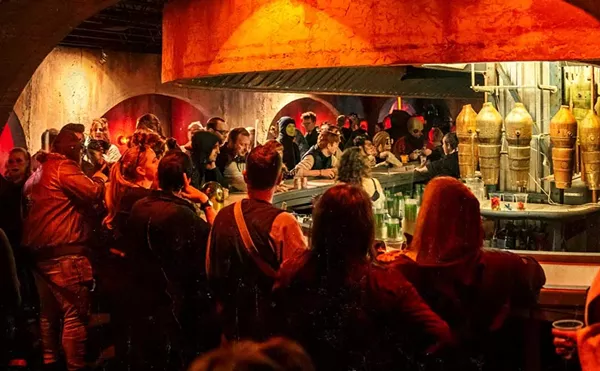
Audio By Carbonatix
[
{
"name": "GPT - Leaderboard - Inline - Content",
"component": "35519556",
"insertPoint": "5th",
"startingPoint": "3",
"requiredCountToDisplay": "3",
"maxInsertions": 100,
"adList": [
{
"adPreset": "LeaderboardInline"
}
]
}
]
In his award-winning The Origins of the Urban Crisis, historian Thomas J. Sugrue used Detroit as the ultimate case study of what happened in the industrial North. Sugrue reconsidered the history to challenge what has often been presented as a simple three-act drama: '60s black unrest, white flight and municipal decline. Sugrue starts his story decades earlier. Origins looked at the racism that hemmed in growing numbers of black city dwellers, at corporate disinvestment and the relocation of industry starting soon after World War II, at government policies (from housing policies to the expansion of freeways, for instance) that fostered segregated suburbs, among other factors.
Sugrue's latest book, Sweet Land of Liberty, states its revisionist goal in its subtitle: The Forgotten Struggle for Civil Rights in the North. And while Detroit isn't the central case, Detroit figures in the story repeatedly, including struggles over jobs and housing and public accommodations, the riot of 1943, the rebellion of 1967, and the pivotal school busing case of the early 1970s. Likewise, Detroiters such as the late Kermit Bailer, later head of the city's law department, appear often.
The book doesn't aim to detract from the heroic struggle against Jim Crow in the South, but to offer a wider context and a messier story. (For one thing, the Northern story lacks such dramatic bookends as, say, Rosa Parks' bus-seat protest and the assassination of Dr. Martin Luther King Jr.)
The following excerpted passage is one that illuminates black life in cities like Detroit after World War II.
The indignities of everyday Jim Crow took a real toll among northern blacks. Kermit Bailer, born in Detroit in 1921, a Tuskegee Airman during World War II, a civil rights activist in the postwar city, describes the exhaustion of living "with racism twenty-four hours a day, seven days a week, thirty days a month, and three hundred and sixty five days a year." Bailer could have been writing about Alabama, but he wasn't. Of mid-twentieth-century Detroit, a place that many called the 'northernmost southern city," Bailer's memories were bitter. "In those days, life was dominated by racial discrimination. ... What I am talking about is living a very narrow life in a large dynamic city with a host of opportunities but for 'whites only.'" The gap between the rhetoric and reality of northern segregation also outraged many black migrants who found themselves negotiating an unpredictable maze of racial proscriptions in the "promised land." Returning veterans were particularly infuriated. William M. Ashby, a longtime Urban League activist in Newark, spoke for his fellow veterans: "They said: I'm tired of all this goddamn crap. Tired of hearing the white man say, 'I can serve no niggers in my restaurant,' tired of being told, 'I ain't got no place for colored in my hotel.' Why, hell, I've been to Europe. Hitler leveled his bullets at me. Missed. I went to the Pacific. Mr. Hirohito sent his madmen to blow me to hell in their planes. I'm still here. Why don't I tell the white man, 'Take your goddam boots off my neck!'"
To negotiate northern Jim Crow was exhausting, demoralizing, and often dangerous. Travelers faced particular risks. Salesmen and railway workers frequently found rooms in Negro YMCAs, even though, as in New York, the Y's dormitories were usually far from train stations and bus depots. Often travelers relied on conversations with redcaps, the black porters who served white railway passengers. Some relief came with the publication of the Negro Motorist Green-Book in 1937, a black Baedeker that gave "the Negro traveler information that will keep him from running into difficulties, embarrassments, and to make his trips more enjoyable." Black newspapers also ran advertisements for "race" hotels and restaurants. Ebony published an annual summer vacation guide beginning in 1947, and over the curse of the 1950s, several other publishers issued competing guides. In Detroit, those with money stayed at the Gotham; in Chicago, they found rooms at the Pershing on the South Side; in New York, at Harlem's Hotel Theresa. Travelers on a tight budget could usually rely on word of mouth to find someone renting out a room in a black neighborhood. Black vacationers could find cabins or tourist rooms in an archipelago of black resorts throughout the Northeast and Midwest, places from Atlantic City, New Jersey, to Idlewild, Michigan.
Even celebrities such as Josephine Baker, Paul Robeson, Dorothy Dandridge, and Marian Anderson had a hard time finding rooms and faced restaurant Jim Crow when they toured the North. When she arrived in New York from Paris in 1948, Baker and her husband were turned away from thirty-six hotels before they found a room. Paul Robeson was expelled from the lobby of Detroit's posh Book-Cadillac Hotel and refused service in an upscale San Francisco restaurant. Lena Horne was bounced from a Chicago restaurant that adopted a "members only" policy as soon as she asked for a table. An Oakland, California, restaurant made Duke Ellington's band sit at a table behind a curtain where they would not be seen by white customers. And in Minneapolis, where she had a singing engagement, Marian Anderson had to stay in the Phyllis Wheatley House, the local black YWCA, because she could not get a hotel room. In Dayton, Ohio, where hotels practiced "stringent discrimination" against blacks, Anderson found accommodations at a white hotel, but only after its staff worked out advance arrangements so she "didn't register or come anywhere near the desk." Occasionally black travelers engaged in subterfuge to get access in white-run restaurants or hotels. One troupe of actors, tired of eating in "all but the cheapest of restaurants" and staying in the "most fleabitten hotels," donned turbans and spoke in "stage gibberish" to gain entrance to white-run hotels. Those who knew foreign languages could take advantage of the ignorance of white proprietors and pass themselves off as Spanish, Arabic, or even in one case "Hebrew." But most black travelers did not risk humiliation of being rebuffed at a hotel or treated rudely at a restaurant. Those traveling in the long stretches of the suburban and rural North where there were few if any blacks, often slept in their cars. They avoided white-run businesses altogether. A public official in Atlantic City, a resort that attracted large number of blacks as well as whites, reported: "It is seldom a sensible colored man will thrust himself in where he is not wanted."
Thomas J. Sugrue addresses the Richard C. Van Dusen Forum on Urban Issues on Thursday, Feb. 26, in Wayne State's McGregor Memorial Conference Center. For information call 313-577-8819.





